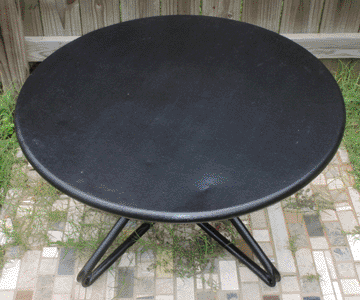

After the success of my previous white paint, I decided to make a black paint in the same manner. This would be useful for objects meant to be unobtrusive, or to provide contrast to light-colored objects, or as a substitute for my asphaltum enamel on objects too large or too temperature-sensitive to be baked in an oven. Initially I experimented with lamp black (carbon soot) as a pigment, since I had some on hand, but found it to be excessively slow-drying in linseed oil, taking nearly a week for a thin layer to fully harden. For subsequent attempts I used mars black (synthetic magnetite), which turned out to be an excellent choice.
To make a paint, I began by weighing out 25 grams of dry pigment, to which I slowly added boiled linseed oil, mixing and mulling until it had a buttery consistency. Initially I attempted to use my ordinary boiled oil, but found this to be too viscous, so to improve the workability I made a special batch of oil, which was heated just long enough to incorporate the drying catalyst. This "soft-boiled" oil is only slightly more viscous than raw oil, but dries much more quickly, and should be suitable for any dark-colored paint. Once this oil was fully incorporated, I weighed the total mass of paint and found that just over six grams of oil had been used; I then thinned it with six grams of turpentine to make it brushable, for a final weight ratio of 4:1:1. These steps can all be seen below.
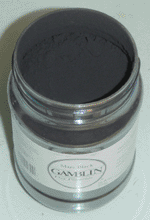
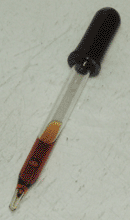
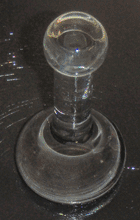
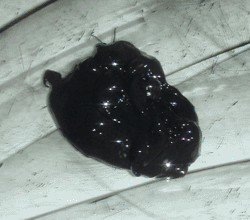
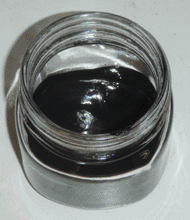
Having determined the correct formula for this type of paint, I then made a larger quantity and used it to repaint an aluminum table. The table had previously been coated with acrylic paint, but this held up poorly outdoors due to the heat of the sun, and had to be removed. Because of the iron content of both the pigment and the oil, the new paint dried relatively quickly, with each coat taking less than a day indoors or roughly an afternoon outdoors. In general, one coat of paint was sufficient to produce an opaque black layer, but I ended up using two coats to cover some problem areas. Unfortunately, this second coat became matte as it dried, indicating a slight deficit of oil in the paint recipe. This was easily remedied, however, by rubbing on more oil with a rag. The final results can be seen at the top of the page.
Overall, I am highly pleased with these paints based on linseed oil. They are easy to make, relatively inexpensive, and appear to hold up well outdoors. If they continue to perform well over time, I see no reason to use any other type of paint for any future projects.
After further investigation of this type of paint, it appears that its matte surface is due to the high rate of drying causing microscopic wrinkling of the oil film. Subsequent oil coats invariably became matte themselves, and the only way I have found to avoid this is to apply a coat of paste wax.
EDIT: 4/22/2025While this type of paint tends to lose its gloss as it dries, this can be corrected (if desired) by the addition of a small amount of tung oil varnish. Boiled linseed oil and oil varnishes are highly compatible, and recent improvements to my varnish formula have reduced its acidity to the extent that it is now generally compatible with even fairly reactive pigments such as zinc oxide. This, along with the recently-discovered possibility of making oil and varnish without an iron catalyst, allows for the above paint to be turned into a self-leveling "enamel paint" in any color including white. While its outdoor durability in this state remains to be determined, the original formula (on the table seen above) is still in good condition after nearly seven years outdoors.